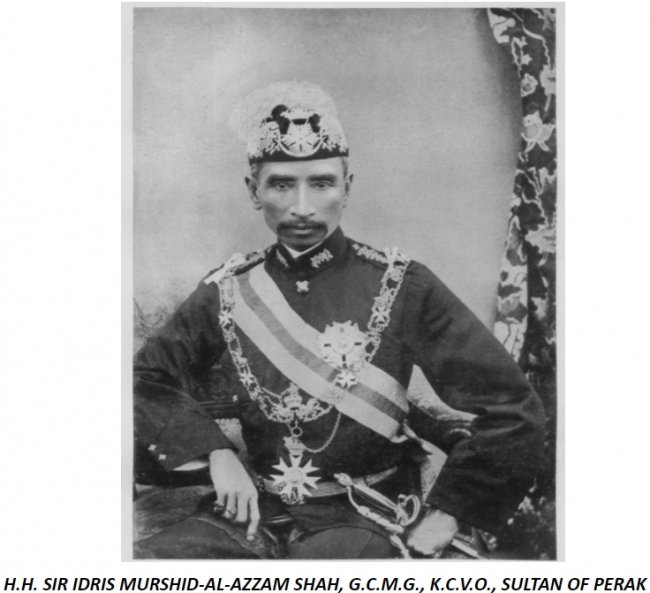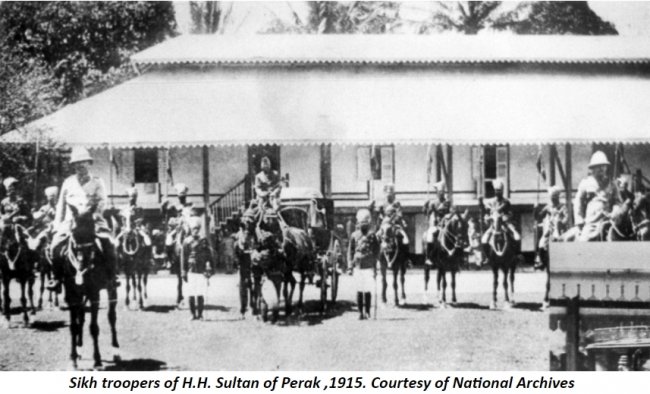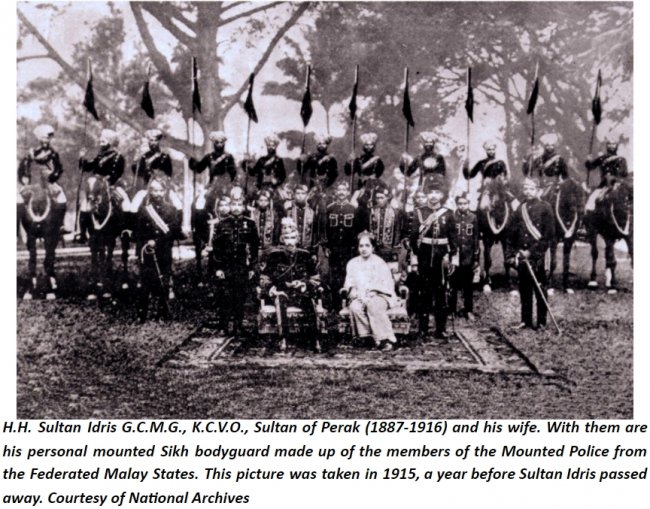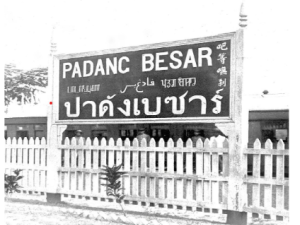[Above image: The bodyguard of H.H. the Sultan of Perak, now in England ,Col. Murray in command. From photos taken on board the P. & O. steamer "Ceylon" by Dr. Reid Mackay. Malayan soldiers travelling to the Coronation of King Edward VII, 1902. Illustration for The Coloured Pictorial, 21 June 1902.]
These magnificent looking men with their long mustaches and whiskers, wearing large blue turbans and pennants on their lances, they comprise a fierce and picturesque army. Their firm seats, smart uniform, clanking swords and the blinding rays of their sword scabbards and lances as they gallop past over the streets will no doubt, invoke admiration from the inhabitants.
Lawlessness on the peninsula along with piracy off its coast began to threaten the stability of the Straits Settlements with the rise of secret societies and skirmishes of Chinese clans became acute in the rich tin mining region of Kinta Valley.
Perak was an early settlement which notably acted as the launch pad to various security deployment in other parts of the country. The British began to recruit brave men from Punjab to serve as policemen and guards in their colonies to help stamp out the secret society feuds in the tin mining area of Perak.
Sikhs made their entry into Malaya in the 19th century and quickly became known for their gallantry in the security forces and their competence in maintaining law and order. Perak was the first Malay State to recruit Sikhs as policemen.
The 1st Battalion Perak Sikhs were formed in 1884 from the paramilitary Perak Armed Police which recruited predominantly Sikhs and Punjabi Muslims/ Pathans in the Malay state. The unit's commander was Commandant Robert Sandilands Frowd Walker (1850-1917). The 1st Battalion Perak Sikhs were involved in security and policing duties in Perak. The unit was used to quell civil unrest, suppress criminal activity and combat the violent feuding of Chinese secret societies.
In December 1883, A small body of cavalry troops consisting of one native officer and fourteen Sowars was established to suppress highway robberies, then of almost daily occurrence in the pass between Taiping, Kamunting & Kinta. They were used to guard the pass at night and due to their vigilance the dangers for travellers soon disappeared. The construction of the Taiping Kinta cart road and other roads in Kinta caused the troopers to be less necessary.
The 1st Battalion Perak Sikhs became the Malay State Guides in 1896. Following the formation of the Guides, the cavalry troop was separated and transferred from Taiping to Kuala Kangsar to form as a Royal Bodyguard and Escort for His Highness the Sultan of Perak. The bodyguard was quartered near the palace in Bukit Chandan and always accompanied His Highness Sultan Idris in his carriage and pair on ceremonial occasions.
The total strength of the bodyguard were, a native officer, two Daffadars (rank equivalent to a Sergeant in the cavalry) and twelve Sowars (mounted orderlies) of Perak Force stationed at Kuala Kangsar as of 1900 (F.M.S. Police report 1900).
His Highness, Sultan Idris (1), The Sultan of Perak was the only ruler in the federation who had a private mounted Sikh bodyguard. These swarthy veterans of fine old Bengal Lancers, have wandered into the service of His Highness and was the only personal bodyguard that has been maintained by a Malay ruler in modern times and it was the only cavalry unit that has ever existed in the country.
This small body of stalwart mounted men formed the Sultan of Perak's bodyguard and provided escorts and took part in celebratory parades for state occasions not only in the Federated Malay States but also in Singapore.
Other than ceremonial use, occasionally, the lancers were being called out to patrol the mining towns of the Kinta district during periods of disturbance.
These magnificent looking men with long mustaches and whiskers, wearing large blue turbans, scarlet coats and white trousers of the cavalry were drawn from the 19th Regiment of Bengal Lancers, one of the most distinguished regiments in the Indian Army. The Perak Lancers were finely built men, well mounted and well trained for ceremonial duty for they were Sikhs who had served in the Indian Cavalry. These Sowars were armed with lance, sword and carbine, and red and white pennons fluttered from the lances. Their attractive scarlet coats, in many instances covered with medals denoting a long active and honourable service, made them intensely interesting.
This picturesque body of mounted men did guard duty, mounted on charges, at the palace and on ceremonial occasions rode in front and behind the state landau. Perak is the only State which has ever maintained a mounted bodyguard for the ruler of the State. The F.M.S. Police report for 1913 stated that the mounted bodyguard of H.H. the Sultan of Perak was maintained at Kuala Kangsar at a strength of one Daffadars, one naik and 13 Sowars, with 13 horses and seven syces.
This devoted bodyguard of picked horsemen remained true to their salt and was only disbanded after the Sultan's death. Their loyalty has been beyond questionable.










